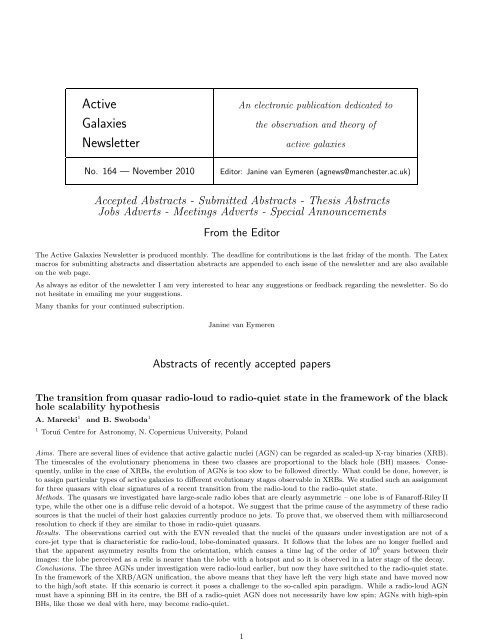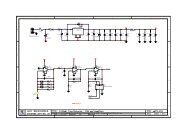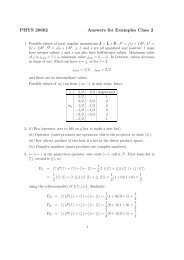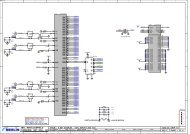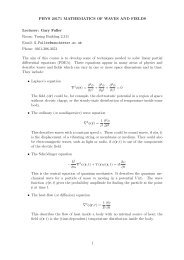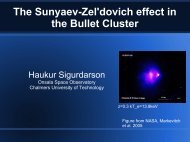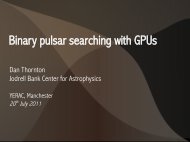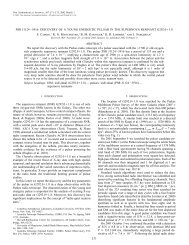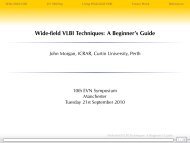Active Galaxies Newsletter
Active Galaxies Newsletter
Active Galaxies Newsletter
You also want an ePaper? Increase the reach of your titles
YUMPU automatically turns print PDFs into web optimized ePapers that Google loves.
1<br />
<strong>Active</strong><br />
<strong>Galaxies</strong><br />
<strong>Newsletter</strong><br />
No. 164 — November 2010<br />
An electronic publication dedicated to<br />
the observation and theory of<br />
active galaxies<br />
Editor: Janine van Eymeren (agnews@manchester.ac.uk)<br />
Accepted Abstracts - Submitted Abstracts - Thesis Abstracts<br />
Jobs Adverts - Meetings Adverts - Special Announcements<br />
From the Editor<br />
The <strong>Active</strong> <strong>Galaxies</strong> <strong>Newsletter</strong> is produced monthly. The deadline for contributions is the last friday of the month. The Latex<br />
macros for submitting abstracts and dissertation abstracts are appended to each issue of the newsletter and are also available<br />
on the web page.<br />
As always as editor of the newsletter I am very interested to hear any suggestions or feedback regarding the newsletter. So do<br />
not hesitate in emailing me your suggestions.<br />
Many thanks for your continued subscription.<br />
Janine van Eymeren<br />
Abstracts of recently accepted papers<br />
The transition from quasar radio-loud to radio-quiet state in the framework of the black<br />
hole scalability hypothesis<br />
A. Marecki 1 and B. Swoboda 1<br />
1 Toruń Centre for Astronomy, N. Copernicus University, Poland<br />
Aims. There are several lines of evidence that active galactic nuclei (AGN) can be regarded as scaled-up X-ray binaries (XRB).<br />
The timescales of the evolutionary phenomena in these two classes are proportional to the black hole (BH) masses. Consequently,<br />
unlike in the case of XRBs, the evolution of AGNs is too slow to be followed directly. What could be done, however, is<br />
to assign particular types of active galaxies to different evolutionary stages observable in XRBs. We studied such an assignment<br />
for three quasars with clear signatures of a recent transition from the radio-loud to the radio-quiet state.<br />
Methods. The quasars we investigated have large-scale radio lobes that are clearly asymmetric – one lobe is of Fanaroff-Riley II<br />
type, while the other one is a diffuse relic devoid of a hotspot. We suggest that the prime cause of the asymmetry of these radio<br />
sources is that the nuclei of their host galaxies currently produce no jets. To prove that, we observed them with milliarcsecond<br />
resolution to check if they are similar to those in radio-quiet quasars.<br />
Results. The observations carried out with the EVN revealed that the nuclei of the quasars under investigation are not of a<br />
core-jet type that is characteristic for radio-loud, lobe-dominated quasars. It follows that the lobes are no longer fuelled and<br />
that the apparent asymmetry results from the orientation, which causes a time lag of the order of 10 6 years between their<br />
images: the lobe perceived as a relic is nearer than the lobe with a hotspot and so it is observed in a later stage of the decay.<br />
Conclusions. The three AGNs under investigation were radio-loud earlier, but now they have switched to the radio-quiet state.<br />
In the framework of the XRB/AGN unification, the above means that they have left the very high state and have moved now<br />
to the high/soft state. If this scenario is correct it poses a challenge to the so-called spin paradigm. While a radio-loud AGN<br />
must have a spinning BH in its centre, the BH of a radio-quiet AGN does not necessarily have low spin; AGNs with high-spin<br />
BHs, like those we deal with here, may become radio-quiet.
2<br />
Accepted by A&A<br />
E-mail contact: amr@astro.uni.torun.pl,<br />
preprint available at arXiv:1010.0651<br />
A Multi-Wavelength Study of the Nature of Type 1.8/1.9 Seyfert <strong>Galaxies</strong><br />
M. L. Trippe 1 , D. M. Crenshaw 2 , R. P. Deo 3 , M. Dietrich 4 , S. B. Kraemer 5 , S. E. Rafter 6 , and T. J. Turner 7<br />
1 Department of Astronomy, University of Maryland, College Park, MD 20742<br />
2 Department of Physics and Astronomy, Georgia State University, One Park Place South SE, Ste. 700, Atlanta, GA 30303<br />
3 Drexel University Department of Physics, Disque Hall, South 32nd St., Rm. 813, Philadelphia, PA 19104<br />
4 Department of Astronomy, The Ohio State University, 4055 McPherson Lab 140 W. 18th Ave. Columbus, OH, 43210<br />
5 Institute for Astrophysics and Computational Sciences, Department of Physics, The Catholic University of America, Washington,<br />
DC 20064<br />
6 Dept. of Physics, Technion, Haifa 32000, Israel<br />
7 Dept. of Physics, University of Maryland Baltimore County, 1000 Hilltop Circle, Baltimore, MD 21250<br />
We focus on determining the underlying physical cause of a Seyfert galaxy’s appearance as type a 1.8 or 1.9. Are these<br />
“intermediate” Seyfert types typical Seyfert 1 nuclei with reddened broad-line regions? Or are they objects with intrinsically<br />
weak continua and broad emission lines? We compare measurements of the optical reddening of the narrow and broad-line<br />
regions with each other and with the X-ray column derived from XMM-Newton 0.5-10 keV spectra to determine the presence<br />
and location of dust in the line of sight. We also searched the literature to see if the objects showed evidence for broad-line<br />
variability, and determined if the changes were consistent with a change in reddening or a change in the intrinsic ionizing<br />
continuum flux. We find that 10 of 19 objects previously classified as Seyfert 1.8/1.9s received this designation due to their<br />
low continuum flux. In four objects the classification was due to BLR reddening, either by the torus or dust structures in the<br />
vicinity of the NLR; in the remaining five objects there is not sufficient evidence to favor one scenario over the other. These<br />
findings imply that, in general, samples of 1.8/1.9s are not suitable for use in studies of the gas and dust in the central torus.<br />
Accepted by ApJ.<br />
E-mail contact: trippe[at]astro.umd.edu,<br />
preprint available at arXiv:1010.2750<br />
Stability of cloud orbits in the broad-line region of active galactic nuclei<br />
Martin Krause 1,2 , Andreas Burkert 1,2,3 , Marc Schartmann 1,2<br />
1 Max-Planck-Institut für Extraterrestrische Physik, Giessenbachstrasse, 85748 Garching, Germany<br />
2 Universitätssternwarte München, Scheinerstr. 1, 81679 München, Germany<br />
3 Max-Planck-Fellow<br />
We investigate the global dynamic stability of spherical clouds in the Broad Line Region (BLR) of <strong>Active</strong> Galactic Nuclei<br />
(AGN), exposed to radial radiation pressure, gravity of the central black hole (BH), and centrifugal forces assuming the clouds<br />
adapt their size according to the local pressure. We consider both, isotropic and anisotropic light sources. In both cases,<br />
stable orbits exist also for very sub-Keplerian rotation for which the radiation pressure contributes substantially to the force<br />
budget. We demonstrate that highly eccentric, very sub-Keplerian stable orbits may be found. This gives further support for<br />
the model of Marconi et al., who pointed out that black hole masses might be significantly underestimated if radiation pressure<br />
is neglected. That model improved the agreement between black hole masses derived in certain active galaxies based on BLR<br />
dynamics, and black hole masses derived by other means in other galaxies by inclusion of a luminosity dependent term. For<br />
anisotropic illumination, energy is conserved for averages over long time intervals, only, but not for individual orbits. This leads<br />
to Rosetta orbits that are systematically less extended in the direction of maximum radiation force. Initially isotropic relatively<br />
low column density systems would therefore turn into a disk when an anisotropic AGN is switched on.<br />
Accepted by MNRAS<br />
E-mail contact: krause@mpe.mpg.de,<br />
preprint available at astro-ph/1007.0112
3<br />
Implications of Dramatic Broad Absorption Line Variability in the Quasar FBQS J1408+3054<br />
P. B. Hall 1 , K. Anosov 1 , R. L. White 2 , W. N. Brandt 3 , M. D. Gregg 4,5 , R. R. Gibson 6 , R. H. Becker 4,5 , and<br />
D. P. Schneider 3<br />
1 Department of Physics and Astronomy, York University, Toronto, ON, Canada<br />
2 Space Telescope Science Institute, Baltimore, MD, USA<br />
3 Department of Astronomy & Astrophysics, Pennsylvania State University, University Park, PA, USA<br />
4 Department of Physics, University of California Davis, Davis, CA, USA<br />
5 IGPP, Lawrence Livermore National Laboratory, Livermore, CA, USA<br />
6 Department of Astronomy, University of Washington, Seattle, WA, USA<br />
We have observed a dramatic change in the spectrum of the formerly heavily absorbed ‘overlapping-trough’ iron low-ionization<br />
broad absorption line (FeLoBAL) quasar FBQS J1408+3054. Over a time span of between 0.6 to 5 rest-frame years, the Mgii<br />
trough outflowing at 12,000 km s −1 decreased in equivalent width by a factor of two and the [Feii] troughs at the same velocity<br />
disappeared. The most likely explanation for the variability is that a structure in the BAL outflow moved out of our line of<br />
sight to the ultraviolet continuum emitting region of the quasar’s accretion disk. Given the size of that region, this structure<br />
must have a transverse velocity of between 1300 km s −1 and 11,000 km s −1 . In the context of a simple outflow model, we<br />
show that this BAL structure is located between approximately 7300 and 73,000 Schwarzschild radii from the black hole. That<br />
distance corresponds to 2.2 to 22 pc, 14 to 140 times farther from the black hole than the Hβ broad-line region. The high<br />
velocities and the parsec-scale distance for at least this one FeLoBAL outflow mean that not all FeLoBAL outflows can be<br />
associated with galaxy-scale outflows in ultraluminous infrared galaxies transitioning to unobscured quasars. The change of<br />
FBQS J1408+3054 from an FeLoBAL to a LoBAL quasar also means that if (some) FeLoBAL quasars have multiwavelength<br />
properties which distinguish them from HiBAL quasars, then some LoBAL quasars will share those properties. Finally, we<br />
extend previous work on how multiple-epoch spectroscopy of BAL and non-BAL quasars can be used to constrain the average<br />
lifetime of BAL episodes (currently >60 rest-frame years at 90% confidence).<br />
Accepted by MNRAS<br />
E-mail contact: phall@yorku.ca,<br />
preprint available at http://arxiv.org/abs/1010.3728<br />
X-QUEST: A Comprehensive X-ray Study of Local ULIRGs and QSOs<br />
Stacy H. Teng 1 and Sylvain Veilleux 1<br />
1 Department of Astronomy, University of Maryland, College Park, MD, 20742, USA<br />
We present results from the X-ray portion of a multi-wavelength study of local ULIRGs and QSOs called QUEST (Quasar-<br />
ULIRG Evolution STudy). The data consist of new and archival X-ray data on 40 ULIRGs and 26 PG QSOs taken with<br />
Chandra and XMM-Newton. A combination of traditional and hardness ratio spectral fitting methods is used to characterize<br />
the X-ray properties of these objects. The absorption-corrected 2-10 keV to bolometric luminosity ratios of the ULIRGs and<br />
PG QSOs suggest that the likelihood for dominant nuclear activity increases along the merger sequence from “cool” ULIRGs,<br />
“warm” ULIRGs, infrared-bright QSOs, and infrared-faint QSOs. The starburst dominates the total power in ULIRGs prior to<br />
the merger, and this is followed by rapid black hole growth during and after coalescence. These results are in general agreement<br />
with those obtained in the mid-infrared with Spitzer and recent numerical simulations.<br />
Accepted by The Astrophysical Journal<br />
E-mail contact: stacyt@astro.umd.edu,<br />
preprint available at http://arxiv.org/abs/1010.4027<br />
Hot-Dust-Poor Type 1 AGNs in the COSMOS Survey<br />
Heng Hao 1 , Martin Elvis 1 , Francesca Civano 1 , Giorgio Lanzuisi 1,2 , Marcella Brusa 3 , Elisabeta Lusso 4 , Gianni<br />
Zamorani 4 , Andrea Comastri 4 , Angela Bongiorno 3 , Chris D. Impey 5 , Anton M. Koekemoer 6 , Emeric Le Floc’h 7 ,<br />
Mara Salvato 8 , David Sanders 7 , Jonathan R. Trump 5 , and Cristian Vignali 9<br />
1 Harvard-Smithsonian Center for Astrophysics, 60 Garden Street, Cambridge, MA 02138<br />
2 INAF - IASF Roma, Via del Fosso del Cavaliere 100, 00133 Roma, Italy<br />
3 Max Planck Institut für extraterrestrische Physik Giessenbachstrasse 1, D–85748 Garching, Germany<br />
4 INAF-Osservatorio Astronomico di Bologna, via Ranzani 1, I-40127 Bologna, Italy<br />
5 Steward Observatory, University of Arizona, 933 North Cherry Avenue, Tucson, AZ 85721, USA<br />
6 Space Telescope Science Institute, 3700 San Martin Drive, Baltimore, MD 21218, USA<br />
7 Institute for Astronomy, University of Hawaii,2680 Woodlawn Drive, Honolulu, HI 96822 USA
4<br />
8 IPP - Max-Planck-Institute for Plasma Physics, Boltzmannstrasse 2, D-85748, Garching, Germany<br />
9 Dipartimento di Astronomia, Università degli Studi di Bologna, Via Ranzani 1, I-40127 Bologna, Italy<br />
We report a sizable class of type 1 AGNs with unusually weak near-infrared (1 − 3µm) emission in the XMM-COSMOS type<br />
1 AGN sample. The fraction of these “hot-dust-poor” AGNs increases with redshift from 6% at low redshift (z < 2) to 20%<br />
at moderate high redshift (2 < z < 3.5). There is no clear trend of the fraction with other parameters: bolometric luminosity,<br />
Eddington ratio, black hole mass and X-ray luminosity. The 3µm emission relative to the 1µm emission is a factor of two to<br />
four smaller than the typical Elvis et al. (1994) AGN spectral energy distribution, which indicates a ‘torus’ covering factor of<br />
2%–29%, a factor of three to forty smaller than required by unified models. The weak hot dust emission seems to expose an<br />
extension of the accretion disk continuum in some of the source SEDs. We estimate the outer edge of their accretion disks to<br />
lie at (0.3 − 2.0) × 10 4 Schwarzschild radii, ∼10–23 times the gravitational stability radii. Formation scenarios for these sources<br />
are discussed.<br />
Accepted by ApJ Letter<br />
E-mail contact: hhao@cfa.harvard.edu,<br />
preprint available at http://arxiv.org/abs/1009.3276<br />
The Compton shoulder of the Fe Kα fluorescent emission line in active galactic nuclei<br />
Tahir Yaqoob 1 and Kendrah D. Murphy 2,3<br />
1 Department of Physics and Astronomy, Johns Hopkins University, Baltimore, MD 21218.<br />
2 MIT Kavli Institute for Astrophysics and Space Research, 77 Massachusetts Avenue, NE80-6013, Cambridge, MA 02139.<br />
3 Department of Physics, Skidmore College, 815 North Broadway, Saratoga Springs, NY 12866.<br />
We present new, high signal-to-noise ratio results from a Monte Carlo study of the properties of the Compton shoulder of the<br />
Fe Kα emission line in the toroidal X-ray reprocessor model of Murphy & Yaqoob (2009). The model is valid for equatorial<br />
column densities in the range 10 22 cm −2 to 10 25 cm −2 , which comprehensively covers the Compton-thin to Compton-thick<br />
regimes. We show how the shape of the Compton shoulder and its flux relative to the core of the Fe Kα emission line depend<br />
on the torus column density and orientation, for the case of a half-opening angle of 60 ◦ and cosmic abundances. The variety of<br />
Compton shoulder profiles is greater than that for both (centrally-illuminated) spherical and disk geometries. Our Monte Carlo<br />
simulations were done with a statistical accuracy that is high enough to reveal, for the case of an edge-on, Compton-thick torus,<br />
a new type of Compton shoulder that is not present in the spherical or disk geometries. Such a Compton shoulder is dominated<br />
by a narrow back-scattering feature peaking at ∼ 6.24 keV. Our results are also sensitive enough to reveal a dependence of the<br />
shape of the Compton shoulder (and its magnitude relative to the Fe Kα line core) on the spectral shape of the incident X-ray<br />
continuum. We also present results of the effect of velocity broadening on the Fe Kα line profile and find that if either the<br />
velocity width or instrument resolution is greater than a FWHM of ∼ 2000 km s −1 , the Compton shoulder begins to become<br />
blended with the line core and the characteristic features of the Compton shoulder become harder to resolve. In particular, at<br />
a FWHM of ∼ 7000 km s −1 the Compton shoulder is not resolved at all, its only signature being a weak asymmetry in the<br />
blended line profile. This means that CCD X-ray detectors cannot unambiguously resolve the Compton shoulder. Our results<br />
are freely available in a format that is suitable for direct spectral-fitting of the continuum and line model to real data.<br />
Accepted by MNRAS<br />
E-mail contact: yaqoob at pha. jhu. edu, preprint available at arXiv<br />
Polycyclic Aromatic Hydrocarbon and Emission Line Ratios in <strong>Active</strong> Galactic Nuclei<br />
and Starburst <strong>Galaxies</strong>.<br />
Sales, Dinalva A. 1 , Pastoriza, M. G. 1,2 and Riffel, R. 1<br />
1 Departamento de Astronomia, Universidade Federal do Rio Grande do Sul. Av. Bento Gonçalves 9500, Porto Alegre, RS,<br />
Brazil<br />
2 Conselho Nacional de Desenvolvimento Científico e Tecnológico, Brazil<br />
We study the polycyclic aromatic hydrocarbons (PAH) bands, ionic emission lines, and mid-infrared continuum properties, in<br />
a sample of 171 emission line galaxies taken from the literature plus 15 new active galactic nucleus (AGN) Spitzer spectra.<br />
We normalize the spectra at λ=23µm and grouped them according to the type of nuclear activity. The continuum shape<br />
steeply rises for longer wavelengths and can be fitted with a warm blackbody distribution of T ∼ 150 –300K. The brightest<br />
PAH spectral bands (6.2, 7.7, 8.6, 11.3, and 12.7 µm) and the forbidden emission lines of [Siii] 34.8 µm, [Arii] 6.9 µm, [S iii]<br />
18.7 and 33.4 µm were detected in all the starbursts and in ∼80% of the Seyfert 2. Taking under consideration only the PAH<br />
bands at 7.7µm, 11.3µm, and 12.7µm we find that they are present in ∼80% of the Seyfert 1, while only half of this type of
5<br />
activity show the 6.2µm and 8.6 µm PAH bands. The observed intensity ratios for neutral and ionized PAHs (6.2µm/7.7µm<br />
× 11.3µm/7.7µm) were compared to theoretical intensity ratios, showing that AGNs have higher ionization fraction and larger<br />
PAH molecules (≥ 180 carbon atoms) than SB galaxies. The ratio between the ionized (7.7µm) and the neutral PAH bands<br />
(8.6µm and 11.3µm) are distributed over different ranges for AGNs and SB galaxies, suggesting that these ratios could depend<br />
on the ionization fraction, as well as on the hardness of the radiation field. The ratio between the 7.7µm and 11.3µm bands<br />
is nearly constant with the increase of [Neiii]15.5µm/[Neii] 12.8µm, indicating that the fraction of ionized to neutral PAH<br />
bands does not depend on the hardness of the radiation field. The equivalent width of both PAH features show the same<br />
dependence (strongly decreasing) with [Neiii]/[Neii], suggesting that the PAH molecules, emitting either ionized (7.7µm) or<br />
neutral (11.3µm) bands, may be destroyed with the increase of the hardness of the radiation field.<br />
Accepted by ApJ 2010<br />
E-mail contact: dinalva.aires@ufrgs.br,<br />
DRAFT is available at Preprints.html<br />
X-ray Emission from Optically Selected Radio-Intermediate and Radio-Loud Quasars<br />
B. P. Miller 1,2,3 , W. N. Brandt 1,4 , D. P. Schneider 1 , R. R. Gibson 5 , A. T. Steffen 6 , and Jianfeng Wu 1,4<br />
1 Department of Astronomy and Astrophysics, The Pennsylvania State University, 525 Davey Laboratory, University Park, PA<br />
16802<br />
2 Department of Physics, The College of Wooster, 308 East University Street, Wooster, OH 44691<br />
3 Department of Astronomy, University of Michigan, 500 Church Street, Ann Arbor, MI 48109<br />
4 Institute for Gravitation and the Cosmos, The Pennsylvania State University, University Park, PA 16802<br />
5 Department of Astronomy, University of Washington, Box 351580, Seattle, WA 98195<br />
6 Department of Astronomy, University of Wisconsin Marathon County, 518 S. 7th Avenue, Wausau, WI 54401<br />
We present the results of an investigation into the X-ray properties of radio-intermediate and radio-loud quasars (RIQs and<br />
RLQs, respectively). We combine large, modern optical (e.g., SDSS) and radio (e.g., FIRST) surveys with archival X-ray data<br />
from Chandra, XMM-Newton, and ROSAT to generate an optically selected sample that includes 188 RIQs and 603 RLQs.<br />
This sample is constructed independently of X-ray properties but has a high X-ray detection rate (85%); it provides broad<br />
and dense coverage of the l − z plane, including at high redshifts (22% of objects have z = 2 − 5), and it extends to high<br />
radio-loudness values (33% of objects have R ∗ = 3 − 5, using logarithmic units). We measure the “excess” X-ray luminosity of<br />
RIQs and RLQs relative to radio-quiet quasars (RQQs) as a function of radio loudness and luminosity, and parameterize the<br />
X-ray luminosity of RIQs and RLQs both as a function of optical/UV luminosity and also as a joint function of optical/UV and<br />
radio luminosity. RIQs are only modestly X-ray bright relative to RQQs; it is only at high values of radio-loudness (R ∗ > ∼ 3.5)<br />
and radio luminosity that RLQs become strongly X-ray bright. We find no evidence for evolution in the X-ray properties of<br />
RIQs and RLQs with redshift (implying jet-linked IC/CMB emission does not contribute substantially to the nuclear X-ray<br />
continuum). Finally, we consider a model in which the nuclear X-ray emission contains both disk/corona-linked and jet-linked<br />
components and demonstrate that the X-ray jet-linked emission is likely beamed but to a lesser degree than applies to the radio<br />
jet. This model is used to investigate the increasing dominance of jet-linked X-ray emission at low inclinations.<br />
Accepted by ApJ<br />
E-mail contact: mbrendan@umich.edu,<br />
preprint available at arXiv:1010.4804<br />
Spectral variability of quasars from multi-epoch photometric data in the Sloan Digital<br />
Sky Survey Stripe 82<br />
H. Meusinger 1 , A. Hinze 2 , A. de Hoon 3<br />
1 Thüringer Landessternwarte Tautenburg, Sternwarte 5, D–07778 Tautenburg, Germany<br />
2 Astronomisches Institut, Universität Bern, Sidlerstraße 5, CH–3012 Bern, Switzerland<br />
3 Astrophysikalisches Institut Potsdam, An der Sternwarte 16, D–14482 Potsdam, Germany<br />
The study of the ensemble properties of the UV/optical broadband variability of quasars is hampered by the combined effects of<br />
the dependence of variability on timescale, rest frame wavelength, and luminosity. Here, we present a new approach to analysing<br />
the dependence of quasar variability on rest frame wavelengths. We exploited the spectral archive of the Sloan Digital Sky Survey<br />
(SDSS) to create a sample of over 9000 quasars in the Stripe 82. The quasar catalogue was matched with the Light Motion Curve<br />
Catalogue for SDSS Stripe 82 and first-order structure functions were computed from the lightcurves. The structure functions<br />
are used to create a variability indicator that is related to the same intrinsic timescales for all quasars (about 1 to 2 yr in the rest<br />
frame). We study the variability ratios for adjacent SDSS filter bands as a function of redshift. A quantitative interpretation
6<br />
of these relations is provided by comparing with the results of simple Monte Carlo simulations of variable quasar spectra. We<br />
confirm the well-known dependence of variability on time-lag; the best power-law fit of the sample-averaged structure function<br />
has a slope β = 0.31 ± 0.03. We also confirm that anti-correlations exist with luminosity, wavelength, and redshift where the<br />
latter can be fully explained as a consequence of the former two dependencies. The variability ratios as a function of redshift<br />
resemble the corresponding colour index-redshift relations. While variability is almost always stronger in the bluer passband<br />
than in the redder, the variability ratio depends on whether strong emission lines contribute to either one band or the other.<br />
We find that the observed variability ratio-redshift relations are well described assuming that (a) the r.m.s. fluctuation of the<br />
quasar continuum flux follows a power law σ(f λ ) ∝ λ −2 (i.e., is bluer when brighter) and (b) the variability of the emission line<br />
flux is only ∼ 10% of that of the underlying continuum. These results, based upon the photometry of more than 8000 quasars,<br />
confirm the previous findings of Wilhite et al. (2005) for 315 quasars with repeated SDSS spectroscopy. Finally, we find that<br />
quasars with unusual spectra and weak emission lines tend to have less variability than conventional quasars. This trend is the<br />
opposite of that expected from the dilution effect of variability due to line emission and may be indicative of high Eddington<br />
ratios in these unusual quasars.<br />
Accepted by A&A<br />
E-mail contact: meus@tls-tautenburg.de,<br />
preprint available at http://fr.arxiv.org/abs/1010.5386<br />
The energy budget for X-ray to infrared reprocessing in Compton-thin and Comptonthick<br />
active galaxies<br />
Tahir Yaqoob 1 and Kendrah D. Murphy 2<br />
1 Department of Physics and Astronomy, Johns Hopkins University, Baltimore, MD 21218.<br />
2 Department of Physics, Skidmore College, 815 North Broadway, Saratoga Springs, NY 12866.<br />
Heavily obscured active galactic nuclei (AGNs) play an important role in contributing to the cosmic X-ray background (CXRB).<br />
However, the AGNs found in deep X-ray surveys are often too weak to allow direct measurement of the column density<br />
of obscuring matter. One method adopted in recent years to identify heavily obscured, Compton-thick AGNs under such<br />
circumstances is to use the observed mid-infrared to X-ray luminosity ratio as a proxy for the column density. This is based on<br />
the supposition that the amount of energy lost by the illuminating X-ray continuum to the obscuring matter and reprocessed into<br />
infrared emission is directly related to the column density and that the proxy is not sensitive to other physical parameters of the<br />
system (aside from contamination by dust emission from, for example, star-forming regions). Using Monte Carlo simulations,<br />
we find that the energy losses experienced by the illuminating X-ray continuum in the obscuring matter are far more sensitive<br />
to the shape of the X-ray continuum and to the covering factor of the X-ray reprocessor than they are to the column density of<br />
the material. Specifically we find that it is possible for the infrared to X-ray luminosity ratio for a Compton-thin source to be<br />
just as large as that for a Compton-thick source even without any contamination from dust. Since the intrinsic X-ray continuum<br />
and covering factor of the reprocessor are poorly constrained from deep X-ray survey data, we conclude that the mid-infrared to<br />
X-ray luminosity ratio is not a reliable proxy for the column density of obscuring matter in AGNs even when there is no other<br />
contribution to the mid-infrared luminosity aside from X-ray reprocessing. This conclusion is independent of the geometry of<br />
the obscuring matter.<br />
Accepted by MNRAS<br />
E-mail contact: yaqoob@pha.jhu.edu
7<br />
Orientation Effects on the Inner Region of Dusty Torus of <strong>Active</strong> Galactic Nuclei<br />
Toshihiro Kawaguchi and Masao Mori<br />
Center for Computational Sciences, University of Tsukuba, Tsukuba, Ibaraki 305-8577, Japan<br />
A sublimation process governs the innermost region of the dusty torus of active galactic nuclei. However, the observed inner<br />
radius of the torus is systematically smaller than the expected radius by a factor of ∼ 1/3. We show that the anisotropy of the<br />
emission from accretion disks resolves this conflict naturally and quantitatively. An accretion disk emits lesser radiation in the<br />
direction closer to its equatorial plane (i.e., to the torus). We find that the anisotropy makes the torus inner region closer to<br />
the central black hole and concave. Moreover, the innermost edge of the torus may connect with the outermost edge of the disk<br />
continuously. Considering the anisotropic emission of each clump in the torus, we calculate the near-infrared flux variation in<br />
response to a UV flash. For an observer at the polar angle θ obs = 25 ◦ , the centroid of the time delay is found to be 37% of the<br />
delay expected in the case of isotropic illumination, which explains the observed systematic deviation.<br />
Accepted by The Astrophysical Journal Letter<br />
E-mail contact: kawaguti@ccs.tsukuba.ac.jp,<br />
preprint available at http://arxiv.org/abs/1010.5799
8<br />
Meetings<br />
The Starburst-AGN Connection under the Multiwavelength Limelight<br />
ESAC, Villanueva de la Cañada (Madrid), Spain<br />
September 14-16, 2011<br />
Webpage: http://www.sciops.esa.int/index.php?project=ESACFACULTY&page=workshop starburstAGN2011<br />
Email: sbagn esac2011@sciops.esa.int<br />
The European Space Agency (ESA) Faculty is pleased to announce the international workshop: ”Starburst-AGN connection<br />
under the multiwavelength limelight”. The workshop will be held at the European Space Astronomy Center of ESA (ESAC),<br />
Villanueva de la Cañada (Madrid), Spain, on September 14-16, 2011.<br />
This workshop aims at gathering observational and theoretical astronomers so as to answer the following questions:<br />
- The ”Starburst-AGN Connection”: a causal relation? With which trend?<br />
- ”Starburst-AGN Connection” at low and high redshift: any evidence for evolution?<br />
- Is there a connection between AGN obscuration and star formation?<br />
- In which way are the star formation and AGN phenomena affected by the environment (i.e. interactions, host galaxy type,<br />
bars)?<br />
- Do stars contribute to AGN fuelling?<br />
Perspective participants are encouraged to visit the workshop web page:<br />
http://www.sciops.esa.int/index.php?project=ESACFACULTY&page=workshop starburstAGN2011,<br />
or contact the workshop organisers at: sbagn esac2011@sciops.esa.int<br />
Important Deadlines:<br />
- First announcement (i.e. this one): October 15, 2010<br />
- Second announcement with registration deadline: February 2011<br />
- Registration deadline: April 2011<br />
- Final program: June 2011<br />
- Workshop: 14-16 September 2011<br />
Narrow-Line Seyfert 1 <strong>Galaxies</strong> and their place in the Universe<br />
Milano, Italy<br />
April 4-6, 2011<br />
Webpage: http://nls1.brera.inaf.it/<br />
Email: nls1@brera.inaf.it<br />
In 1978, Davidson and Kinman wrote about Markarian 359: “This unusual object merits further observations...”. In 1985,<br />
Osterbrock and Pogge defined a new class of active galactic nuclei (AGN), named Narrow-Line Seyfert 1 (NLS1). Twenty-five<br />
years later, NLS1s still continue to intrigue and bewilder. NLS1s manifest extreme behaviour at all wavelengths. They exhibit<br />
the most extreme X-ray variability seen in radio-quiet AGN, the most intense optical FeII emission, and high rates of star<br />
formation. In general, their characteristics are consistent of AGNs with relatively low mass black holes accreting close to the<br />
Eddington rate. The 2009 Fermi Gamma-ray Space Telescope discovery of high-energy (E > 100 MeV) gamma rays in a handful<br />
of NLS1s has established the existence of relativistic jets in these systems – a fact previously hinted at by the flat radio spectrum<br />
and high brightness temperature seen in some objects. Since NLS1 are generally hosted by spirals, this poses some intriguing<br />
questions on the galaxy evolution and on how relativistic jets are generated.<br />
It is therefore time for the broad community to come together and discuss what we have discovered in the last quarter century<br />
and lay the foundation for future work. We propose to meet in Milano on April 4-6 2011 for a workshop dedicated to NLS1<br />
and focused on these topics:<br />
- Central engine: BH mass, accretion disk, BLR/NLR, jet
9<br />
- Host galaxy: morphology, star formation, merging history<br />
- NLS1 in the Universe: comparison with other types of AGN, surveys/statistics, formation/merging, cosmological evolution<br />
Invited speakers:<br />
- Todd Boroson<br />
- Andy Fabian (to be confirmed)<br />
- Bradley Peterson<br />
- Richard Pogge<br />
Deadline for abstract submission and registration: 31 January 2011<br />
Scientific Organizing Committee: M. Colpi (University Milano Bicocca, Italy); L. Foschini (INAF OA Brera, Italy,<br />
Chair); L. Gallo (St. Mary’s University, Canada); D. Grupe (Penn State University, USA); S. Komossa (MPE, Germany);<br />
K. Leighly (University of Oklahoma, USA); S. Mathur (Ohio State University, USA).<br />
Local Organizing Committee: C. Bernasconi; G. Bonnoli; G. Ghirlanda; G. Ghisellini; F. Taddei; F. Tavecchio.


